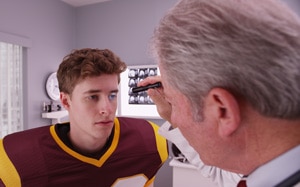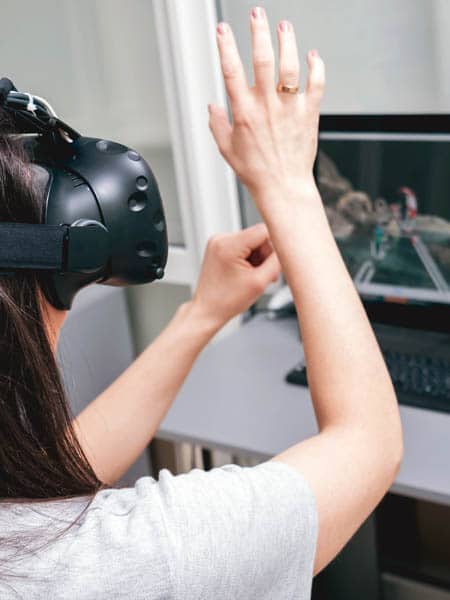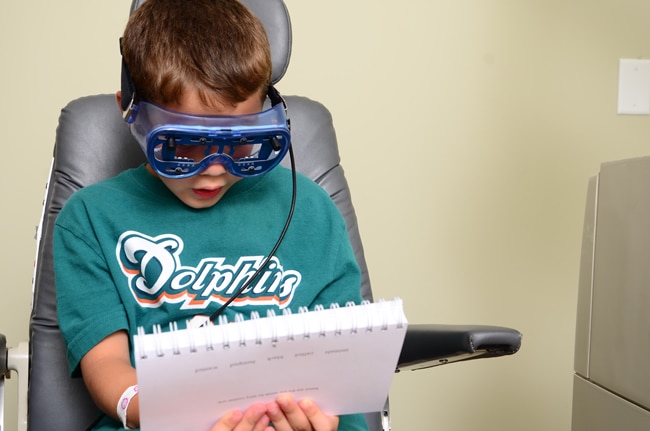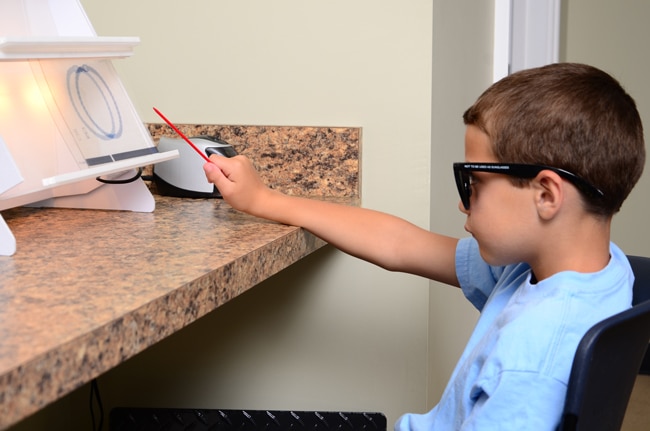Vision Therapy
What is Vision Therapy?

Vision Therapy
What is Vision Therapy?
Vision Therapy is a non-surgical treatment program that builds new neural pathways in your brain to process information from your eyes more efficiently. 80% of what we learn is learned through visual perception.
While glasses or contacts can compensate for vision that is less than 20/20, Vision Therapy “teaches” the brain and eyes to work together optimally. It is a highly effective treatment for children or adults experiencing perceptual and visual problems. Vision Therapy is designed to strengthen visual skills, eliminate visual problems, reduce visual stress and discomfort, and increase visual performance.
Think of Vision Therapy as a type of physical therapy for the eyes and the brain. In physical therapy, you relearn or enhance the use of various muscles and body parts that are not functioning properly. In Vision Therapy you relearn or enhance the function of eye teaming, tracking, convergence, visual perception, eye-hand coordination and visual motor integration. This is possible because vision is a learned process.

Vision Therapy has been found highly effective at helping school children read, write, learn, and achieve better results in all of their activities. It can help people of all ages recover from vision problems related to concussion, brain damage, injury, and strokes. It can frequently help in the relief of eye strain, computer vision fatigue, and many more common problems. It can also help athletes achieve a high level of success!

Vision Therapy
How Our Brains Impact our Vision
The Brain Plays a Huge Roll in Vision Therapy
For some people, the very idea of Vision Therapy goes against everything they think they understand about why people have trouble seeing and what can be done about it. Most people tend to think that treatment starts and stops at glasses, contact lenses, or corrective surgery. However, they often fail to understand how our brains work.
Everyone has heard the saying that claims “you can’t teach an old dog new tricks.” However, any neurologist can tell you that this isn’t necessarily the case when it comes to the human brain. It is not a fast or easy treatment, but it’s definitely something that can be done.
The brain comes attached to a high degree of neuroplasticity. Neuroplasticity refers to the brain’s ability to change both in structure and function in response to the right external stimuli. At one point, neuroplasticity was considered to be a quality only found in the brains of very young children. However, we now know that this isn’t true. There is quite a bit of evidence to suggest the brains of older children and adults still very much possess this quality.

When a given person has 20/20 vision, but still has vision problems, it’s possible that their brain and eyes need to relearn how to work together properly. That’s where Vision Therapy comes in, by tapping into the brain’s natural penchant for neuroplasticity and teaching it a few new tricks when it comes to how to process the information received from the eyes.

Vision Therapy
Vision Problems Are Not Always Noticeable
This is how a person with a learning-related vision problem might see the print when they read despite having 20/20 vision:

Does your child skip words or lines when reading? Lose his place? Have difficulty with reading comprehension? We can show you how your child’s eyes move when reading to help determine if a visual problem is interfering with her ability to learn. See Demo Below

Vision Therapy
What Conditions Can be Helped with Vision Therapy?
Vision therapy can often help improve visual acuity in children and adults whose vision problems cannot effectively be treated or eliminated with glasses, contact lenses or patching of one eye.
A program of vision therapy is sometimes the best course of action to address visual difficulties that result in crossed or drifting eyes.
The following visual difficulties, whether in children or adults, may benefit from Vision Therapy:
Vision Problems Related to Learning Difficulties
Individuals who are lacking necessary visual skills can be helped through Vision Therapy. These skills include those necessary for reading, writing and learning. Specifically, the individual may have difficulty controlling eye movement and focusing properly. In addition, children and adults who have difficulty with convergence, visual memory skills and hand-eye activities may benefit from a prescribed course of Vision Therapy.
Poor eye coordination (inadequate binocular vision)
For the eyes to work properly, they must coordinate and work together as a team. This gives us binocular vision. When the eyes do not work together as a team, difficulties develop in proper performance. The individual may struggle with problems in reading, with depth perception, difficulties in sports and problems making eye contact.
Convergence Insufficiency
This disorder is the leading cause of many common eye complaints, such as eyestrain, double vision (diplopia), blurred vision and headaches. It can interfere with a person’s ability to see in general, to read and learn effectively, and to work at close distances.
A study completed by the National Eye Institute showed Vision Therapy done in the office and under the supervision of a trained eye care professional has the highest rate of improvement and/or elimination of this disorder.
Vision Therapy for Amblyopia, Diplopia and Strabismus
Vision therapy for lazy eye has shown a more substantial cure rate when compared to more traditional treatments such as surgery on the affected eye(s), prescription eyeglasses and/or patching alone. Lazy eye, or amblyopia, can be helped regardless of age. Vision therapy can also improve or eliminate double vision (diplopia) and crossed-eyes, wandering eyes and eye turns (strabismus).
Vision therapy has shown that age is not a factor in the effectiveness of treatment, disproving the long-held belief that a child with lazy eye could not be helped if he/she was past age 7.
Injury-Related Vision Issues including Concussions
Vision therapy can even help those suffering from vision problems related to stroke, injury, or other conditions.
Post-stroke, many patients suffer from compromised visual fields that affect their ability to stand, balance, walk properly, read and write properly. Our office offers different tools to help patients regain their “normal” vision.
Concussion patients often report blurred vision, difficulty changing focus from near to far, double vision, and difficulty with busy environments such as grocery stores. Vision therapy often helps to regain life pre-concussion.
Special Needs and Attention Disorders
Certain disorders associated with developmental delays can also see improvement through a regimen of Vision Therapy. Some of these special needs that can benefit from visual rehabilitation are:
- visual-perceptual deficits
- visual-motor deficits
- autism spectrum disorder
Sports Vision
Success in any sport is dependent on strong visual skills. It all comes down to coordination: your eyes must transmit visual signals that your brain uses to tell your hands and body how to react to the situation and what to do. Vision Therapy exercises and treatments under the care of a Vision Therapy Specialist can measure and help improve eye-to-hand coordination and visual reaction time. Vision Therapy can improve peripheral vision and the eye’s ability to focus. The ability of the eyes to work as a team and to track can also show dramatic improvement with Vision Therapy. Children and adults can show improvement in coordination abilities and sports through Vision Therapy.

Vision Therapy
How Patients Benefit from Vision Therapy
Vision Therapy isn’t just for children. Anyone, at any age who is experiencing a visual performance problem can benefit from Vision Therapy.
Children struggling in school experiencing problems with reading, spelling or writing, taking longer to complete assignments than their peers, performing poorly on timed tests, received a diagnosis of ADD/ADHD, are on the autism spectrum or developmentally delayed have a 70-80% chance of having a vision problem significant enough to affect their performance and are candidates for Vision Therapy.
Professional athletes use Vision Therapy to increase their visual reaction times and improve their hand-eye coordination. Athletes commonly use Interactive Metronome combined with Vision Therapy to increase their processing speed and enhance their ability to focus and “filter out” distractions.
Computer users experiencing eye strain resulting from binocular vision problems can benefit from Vision Therapy to reduce discomfort.
Adults who have suffered strokes or head trauma (traumatic brain injury, or concussions) can benefit from Vision Therapy.

Adults who have suffered strokes or head trauma (traumatic brain injury, or concussions)can benefit from Vision Therapy.
CONTACT US
Vision Care & Therapy Center

Dr. Janna Iyer, FCOVD
Dr. Alayna Larsen
11735 Pointe Place
Roswell, Ga 30076
678-256-3990
Office Hours
Mon-Thu 9:00am-6:00pm
Fri 9:00am-1:00pm
Appointments
678-256-3990
Patient Infomation





